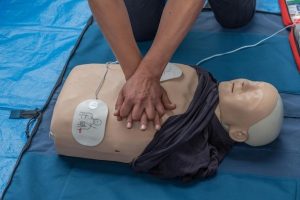In urgent medical situations where someone’s heart stops, performing cardiopulmonary resuscitation (CPR) correctly can significantly increase their chances of survival. Dr Innocent Okoye, a cardiologist from COOUTH, Amaku, Awka, Anambra State, emphasizes the importance of acting swiftly and confidently.
Here’s a detailed guide to executing CPR with precision, backed by expert advice.
Assess the safety of your surroundings
First, ensure your immediate environment poses no danger to you or the victim. Dr. Okoye advises checking for hazards such as chemical spills or electrical dangers. If the area is safe, you can proceed to check on the victim.
Check the victim
Gently tap the victim and loudly ask if they are okay to gauge their responsiveness. Dr. Yusuf Kamiyo, an emergency care specialist based in Surulere, Lagos, suggests that If there is no response, check their breathing. Remember, occasional gasps are not normal breathing.
Alert the authorities
Call the local emergency number or police for help immediately if the situation is dire. If others are nearby, instruct someone to make the call so you can start CPR right away.
Begin CPR
If an Automated External Defibrillator (AED) is available and you are trained to use it, set it up immediately. Reports by Geri Piazza, an author at the NIH (National Institutes of Health), indicate, ‘An AED can drastically improve survival rates if used within the first few minutes of a cardiac arrest.’ If an AED isn’t available, begin chest compressions without delay.
Real-life incidents emphasizing the need for AEDs
Sudden cardiac arrest can strike anyone at any time, affecting all ages—from infants to seniors—often without warning. This reality underscores the need for AEDs in various settings, such as workplaces, fitness centers, and public areas.
For instance, on 22nd November 2021, a tragic incident occurred at the Nnamdi Azikiwe International Airport in Abuja, where Aniekan Effiong, an Assistant General Manager of Operations with the Nigerian Airspace Management Agency, suddenly slumped and passed away.
Just days later, a lecturer from the Federal Polytechnic, Offa, Kwara State, also tragically died after collapsing during a community meeting. These cases highlight the unpredictable nature of cardiac emergencies and the critical importance of immediate response tools like AEDs in public and private sectors.

How to perform chest compressions
• Kneel beside the victim and locate the center of their chest.
• Place the heel of one hand on the center of the chest at the nipple line and the other hand on top, interlocking your fingers.
• Keep your elbows straight and shoulders directly above your hands.
• Use your upper body weight to compress the chest at least two inches deep at a rate of 100 to 120 compressions per minute.
Use the AED
Once the AED is set up, follow the vocal instructions it provides. These will guide you through placing the pads correctly and administering a shock. The AED’s instructions are clear and designed to be followed even by someone with no medical training.
Continue CPR
After administering a shock, or if the AED instructs you to continue, keep performing CPR. “Hands-only” CPR is highly effective in the critical first minutes following cardiac arrest in adults and teenagers. Continue until the person shows signs of life, such as breathing, an ambulance arrives, or you are physically unable to continue.
Post-CPR steps
Once help arrives, inform the medical personnel about the CPR duration and any actions taken during the emergency. Providing these details can be crucial for the ongoing treatment of the victim.
Why learning CPR is crucial
Understanding and performing CPR can be the pivotal factor in saving a life during cardiac emergencies. Regular training and refreshers can help maintain the competence and confidence needed to perform these potentially lifesaving steps effectively.
This comprehensive approach to CPR, reinforced by expert insights, ensures that you are prepared to act decisively and effectively, increasing the cardiac arrest victim’s chances for a better outcome. Remember, your actions can save a life.


